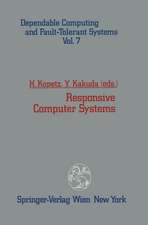Simplicity is Complex: Foundations of Cyber-Physical System Design
Autor Hermann Kopetzen Limba Engleză Paperback – 14 aug 2020
This book investigates the characteristics of simple versus complex systems, and what the properties of a cyber-physical system design are that contribute to an effective implementation and make the system understandable, simple to use, and easy to maintain. The targeted audience is engineers, managers and advanced students who are involved in the design of cyber-physical systems and are willing to spend some time outside the silo of their daily work in order to widen their background and appreciation for the pervasive problems of system complexity.
In the past, design of a process-control system (now called cyber-physical systems) was more of an art than an engineering endeavor. The software technology of that time was concerned primarily with functional correctness and did not pay much attention to the temporal dimension of program execution, which is as important as functional correctness when a physical process must be controlled. In the ensuing years, many problems in the design of cyber-physical systems were simplified. But with an increase in the functional requirements and system size, the complexity problems have appeared again in a different disguise. A sound understanding of the complexity problem requires some insight in cognition, human problem solving, psychology, and parts of philosophy.
This book presents the essence of the author’s thinking about complexity, accumulated over the past forty years.
| Toate formatele și edițiile | Preț | Express |
|---|---|---|
| Paperback (1) | 923.31 lei 6-8 săpt. | |
| Springer International Publishing – 14 aug 2020 | 923.31 lei 6-8 săpt. | |
| Hardback (1) | 929.60 lei 6-8 săpt. | |
| Springer International Publishing – 18 iul 2019 | 929.60 lei 6-8 săpt. |
Preț: 923.31 lei
Preț vechi: 1154.14 lei
-20% Nou
Puncte Express: 1385
Preț estimativ în valută:
176.70€ • 183.79$ • 145.87£
176.70€ • 183.79$ • 145.87£
Carte tipărită la comandă
Livrare economică 14-28 aprilie
Preluare comenzi: 021 569.72.76
Specificații
ISBN-13: 9783030204136
ISBN-10: 3030204138
Pagini: 148
Ilustrații: X, 148 p. 15 illus.
Dimensiuni: 155 x 235 mm
Greutate: 0.23 kg
Ediția:1st ed. 2019
Editura: Springer International Publishing
Colecția Springer
Locul publicării:Cham, Switzerland
ISBN-10: 3030204138
Pagini: 148
Ilustrații: X, 148 p. 15 illus.
Dimensiuni: 155 x 235 mm
Greutate: 0.23 kg
Ediția:1st ed. 2019
Editura: Springer International Publishing
Colecția Springer
Locul publicării:Cham, Switzerland
Cuprins
1. Introduction.- 2. Understanding and Complexity.- 3. Information versus Data.- 4. Modeling.- 5. Multi-Level Hierarchies.- 6. Cyber-Physical Systems are Different.- 7. Simplification.- 8. Communication Systems.- 9. Interface Design.- 10. Annex: Basic System Concepts.- Addendum.- Index.
Notă biografică
Hermann Kopetz received a PhD degree in Physics sub auspiciis praesidentis from the University in Vienna in 1968 and is since 2011 professor emeritus at the Technical University of Vienna. He is the chief architect of the time-triggered technology for dependable embedded Systems and a co-founder of the company TTTech. The time-triggered technology is deployed in leading aerospace, automotive and industrial applications.
Kopetz is a Life Fellow of the IEEE and a full member of the Austrian Academy of Science. Kopetz served as the chairman of the IEEE Computer Society Technical Committee on Dependable Computing and Fault Tolerance and in program committees of many scientific conferences. He is a founding member and a former chairman of IFIP WG 10.4. Kopetz has written a widely used textbook on Real-Time Systems and published more than 200 papers.
Textul de pe ultima copertă
This book investigates the characteristics of simple versus complex systems, and what the properties of a cyber-physical system design are that contribute to an effective implementation and make the system understandable, simple to use, and easy to maintain. The targeted audience is engineers, managers and advanced students who are involved in the design of cyber-physical systems and are willing to spend some time outside the silo of their daily work in order to widen their background and appreciation for the pervasive problems of system complexity.
In the past, design of a process-control system (now called cyber-physical systems) was more of an art than an engineering endeavor. The software technology of that time was concerned primarily with functional correctness and did not pay much attention to the temporal dimension of program execution, which is as important as functional correctness when a physical process must be controlled. In the ensuing years, many problems in the design of cyber-physical systems were simplified. But with an increase in the functional requirements and system size, the complexity problems have appeared again in a different disguise. A sound understanding of the complexity problem requires some insight in cognition, human problem solving, psychology, and parts of philosophy.
This book presents the essence of the author’s thinking about complexity, accumulated over the past forty years.
Caracteristici
Helps designers of cyber-physical systems by thinking about the complexity of such systems, and how to tackle problems. Looks at different notions of complexity to connect them to practical examples in real-time system Offers time-triggered protocols and architecture techniques to tame complexity in real-time system design. Explains how complexity not only relates to engineering or scientific tasks but also has deeper roots in human cognition, psychology, and philosophy. Examples from actual systems are included throughout, so that readers can see how abstract principles are applied.





























